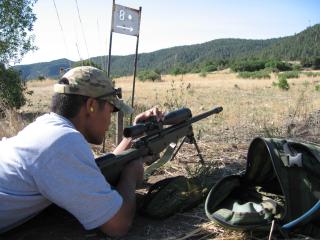Scope Adjustments
This is a good time to adjust the scope magnification setting. In Part I and Part II, I recommend
scopes with intermediate magnification, such as 3-12 or 4-16. A common mistake is to firstly buy a
scope with too much magnification, and secondly to use the maximum magnification all the time. As
the magnification is increased, the field of view narrows and the exit pupil gets smaller. This
makes it harder to locate targets and for magnum calibers, to maintain a sight picture through
recoil. Mirage is worse at higher magnification, and it can be a problem if it prevents a good
consistent sight picture. If you are shooting one target at a time and you already know exactly
where they are located, shooting at a power between 12 and 16 is probably fine. If you are going to
need to rapidly acquire a second target or the targets are hard to locate, consider shooting at
5-10x instead.
308 155 LAP: 2840fps
100yd zero 7500'DA
wind RANGE elev
0.1 100 0.0
1" 0.2 150 0.1
1" 0.3 200 0.4
3" 0.3 250 0.7
4" 0.4 300 1.0
6" 0.5 350 1.4
8" 0.6 400 1.7
10" 0.7 450 2.1
0.8 500 2.5
0.8 550 3.0
0.9 600 3.4
1.0 650 3.9
1.1 700 4.4
1.2 750 4.9
1.3 800 5.4
1.4 850 6.0
1.6 900 6.6
1.7 950 7.2
1.8 1000 7.9
Want a set of cards from DEMIGOD LLC? Click here With this elevation number in mind, dial the scope's elevation knob to correspond to the the elevation correction. I usually double check since this is one of the most important settings.Next, consult the range-card for the windage correction for this distance. All my range cards report the windage correction for a 10 mph wind. With this number in mind, I observe the conditions and determine what proportion of a full 10 mph wind value is present. It might be a third, half, or even two times a 10 mph wind value. There are two choices how to apply this wind correction to the scope. The first is to dial the correction on the windage knob. The second is to hold off with the reticle, if it has features, such as mil dots or hashes, which are regular and calibrated in the units on your range card. Holding off is faster and less error prone to correcting in the wrong direction. Dialing will give you a better sight picture since you'll be holding the target in the center of the cross-hairs. Example
We have ranged the target at 754 yards, which we round down to 750. On our data-card, the
elevation for 750 is 4.9 mils. We dial 4.9 mils on the elevation knob. The windage for a full 10
mph wind value at 750 yards is 1.2 mils. We determine that there is a 3-5 mph wind left to right,
so we dial 4/10*1.2 = 0.5 mil left windage. At this point you've determined the range, made your wind call, made all the scope adjustments, and you're in position. |
